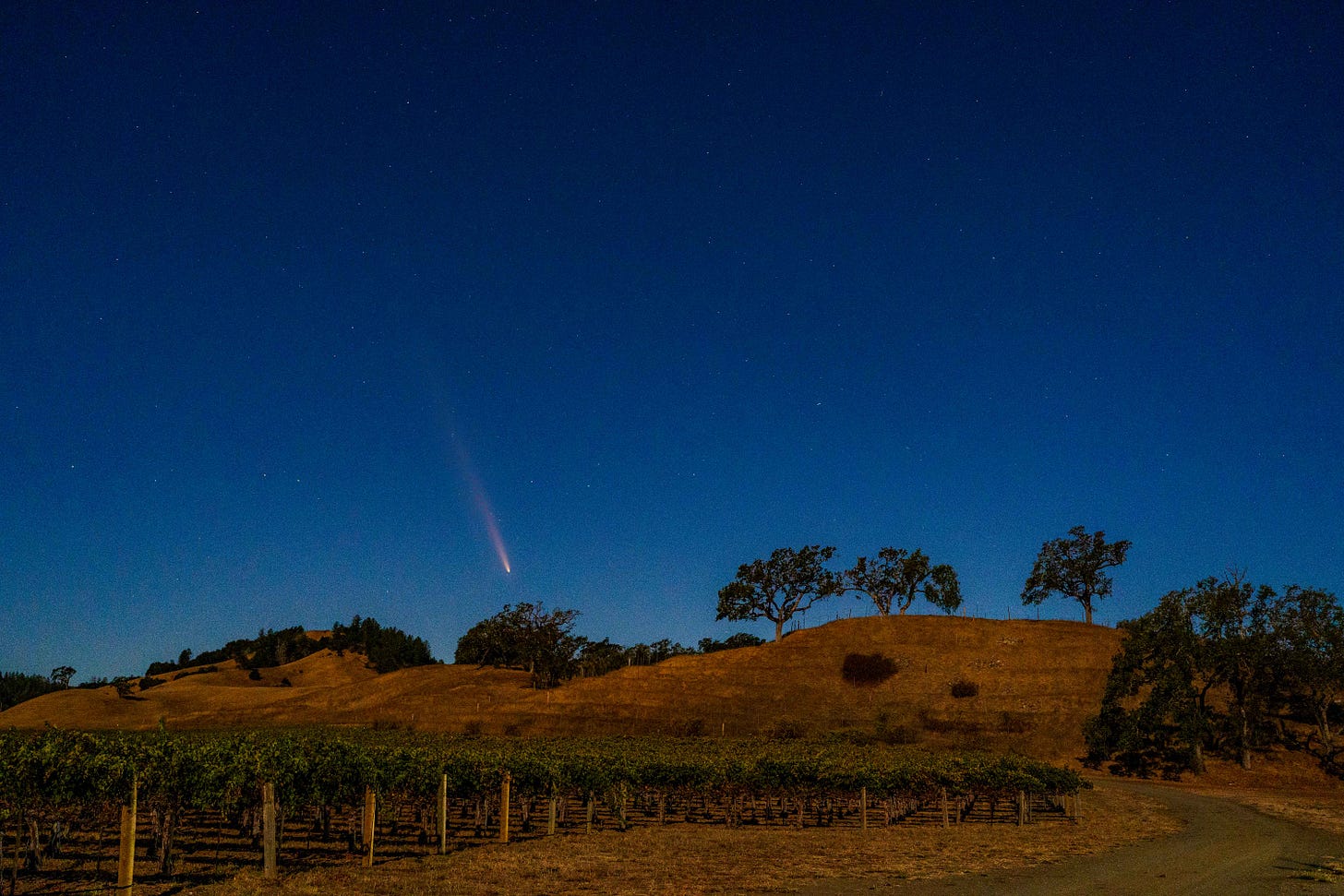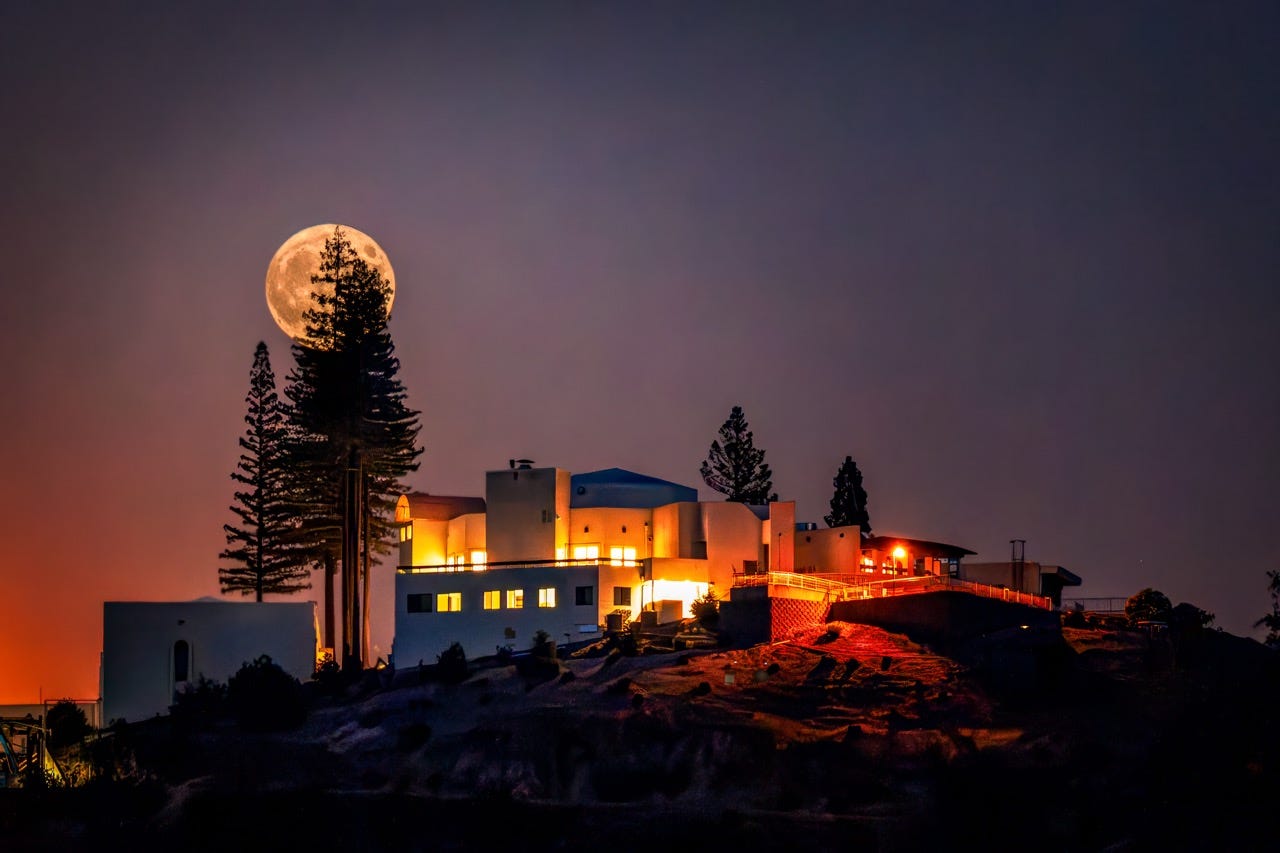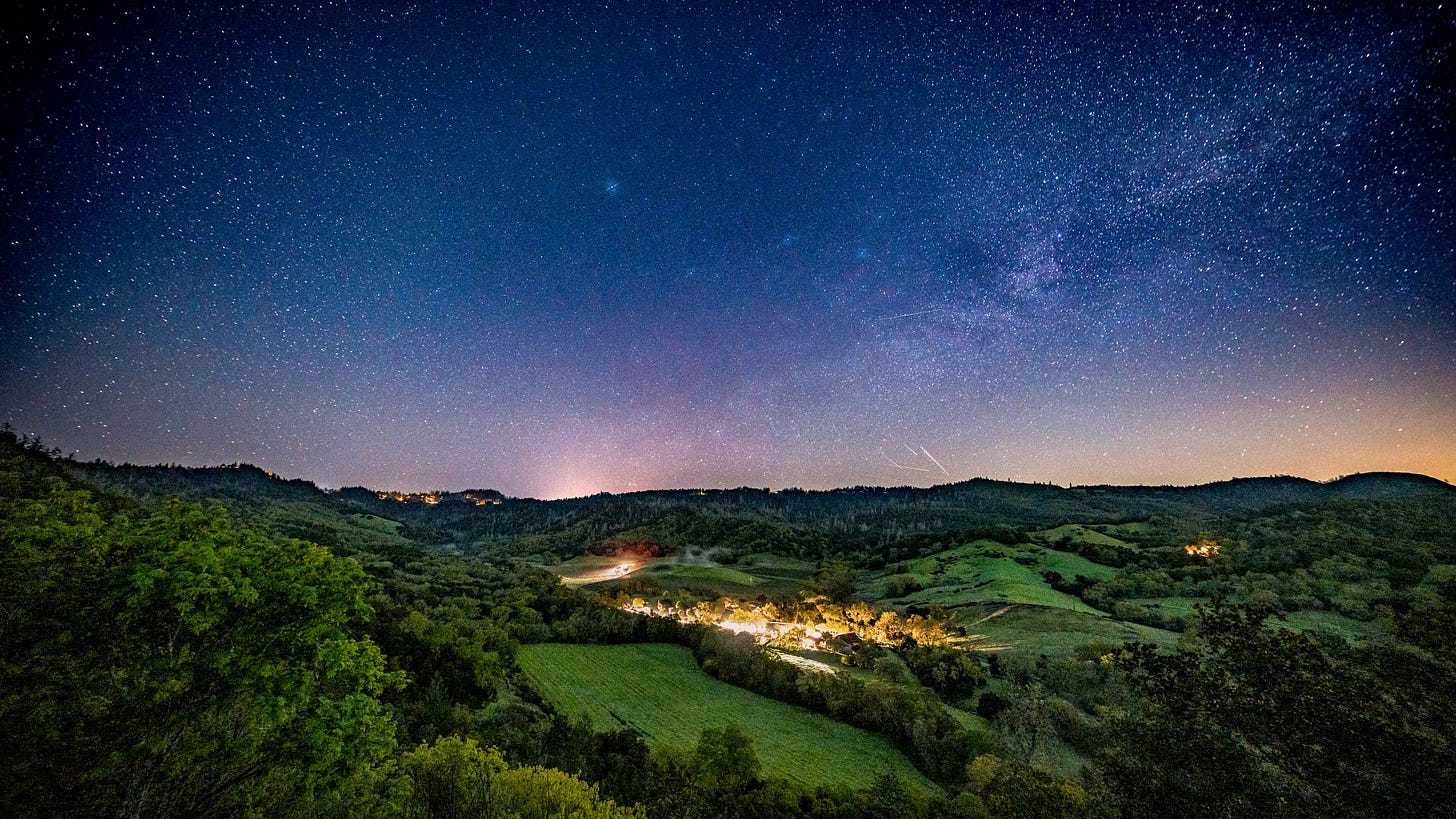Green Wednesday: Manzanita’s Beauty and Napa’s Starry Skies
By Kathleen Scavone, Environmental Contributor and Cindy Kerson, UC Master Gardener of Napa County
Support Napa Valley Features – Become a Paid Subscriber Today
If you’re reading this, you care about independent, locally owned, ad-free journalism — reporting that puts our region’s stories first, not corporate interests or clickbait.
As local newsrooms are increasingly bought by billionaires, scaled back or absorbed into media conglomerates, communities lose original reporting and are left with more syndicated content. Your support keeps quality regional journalism alive.
Join a community that values in-depth, independent reporting. Become a paid subscriber today — and if you already are, thank you. Help us grow by liking, commenting and sharing our work.
Green Wednesday: Gardening and Climate Insights
Every Wednesday, Napa Valley Features brings you Green Wednesday, featuring articles from environmental voices and the UC Master Gardeners of Napa County. These contributors share research-based horticultural advice and insights on sustainability and climate topics relevant to our region.
Summary of Today’s Stories
"Napa's Night Skies" by Kathleen Scavone, environmental contributor: As winter rains subside, Napa’s night skies reveal celestial wonders, from planetary alignments to the International Space Station, inviting stargazers to explore the universe’s vast beauty.
"Engage your sense of wonder as you explore aspects of Napa's night skies." - Kathleen Scavone
"Enjoy Year-Round Garden Magic With Manzanita" by Cindy Kerson, U.C. Master Gardeners of Napa County: Manzanita, a resilient and versatile native plant, provides year-round beauty, supports pollinators and thrives in Napa’s dry climate, making it a top choice for fire-resistant and low-water landscaping.
"Given this staggered flowering, there is almost always some type of manzanita in bloom during the months when other plants are dormant." - Cindy Kerson
Napa's Night Skies
By Kathleen Scavone
NAPA VALLEY, Calif. — When winter's crucial rains subside, opportunities for stargazing Napa Valley's rich and rewarding night skies beckon. February has provided space cases with plentiful planetary viewing opportunities with an outstanding alignment of seven planets: Mars, Jupiter, Uranus, Neptune, Venus, Saturn and Mercury, according to the astronomy app Star Walk.
While the sight of the planet's alignment is not rare, the typical number of planets appearing is usually four. National Geographic explains that the planets will appear bright to us earthlings even under a city's brightly lit night sky but recommends breaking out your binoculars or even a small telescope for the best views. This procession of planets, which will be visible into the middle of March, is naturally spread across space by millions of miles and follows the path of the ecliptic, or Earth's orbital plane around the sun.
Details of February's view of our moon and solar system's planets can be viewed on NASA's website, which divulges planetary visibility for celestial objects such as Venus, the second planet from the sun that is about 24 million miles away. And since February is the traditional month for love, what better object to view, since Venus is the Roman goddess of love? Also seen is Saturn, which, albeit fuzzy, is still visible for the first hour after sunset to the west. Jupiter more than makes up for faint Saturn with a bright show just overhead all month. And that's just the tip of the nebula.
There are many apps, podcasts and websites to direct you to what is up in space at any given time. Astronomy Magazine has features called “The Sky This Week” and “The Sky This Month” that give explanations about the celestial events of the day or month. For example, did you know that on Feb. 23 Mars will be visible all throughout the night and will form a stunning triangle with Castor and Pollux, which are the brilliant starts in the constellation Gemini?
Have you ever gone International Space Station hunting? Yes, it's true, you can sometimes spot the ISS from your own backyard. The ISS began assembly more than 25 years ago and is a collaboration between NASA, JAXA (the Japanese space agency), Roscosmos (the Russian space corporation), ESA (the European Space Agency) and CSA (the Canadian Space Agency).
You have no doubt been hearing reports of the plight of ISS Expedition 72 and American astronauts Suni Williams and Butch Wilmore, who were scheduled to return to Earth after a one-week stay aboard the ISS but may not arrive home until March or April due to a technical issue. It's fun to spot the ISS from your backyard, and with NASA's Spot the Station website, you can learn when it will silently glide over Napa. NASA explains that viewings commence within a few hours of sunset or sunrise since our star — the sun — shows the ISS off to maximum effect during those times due to its reflection on the craft. You can also sign up for alerts on their website.
Engage your sense of wonder as you explore aspects of Napa's night skies. The tilt of Earth's axis in winter allows us to see some of the most stunning stars. As you direct your gaze aloft, your curiosity will reward you with the beauty and multiplicity that the depths of the universe provide.
Napa Valley's 2025 Astronomical Almanac
NAPA VALLEY, Calif. — Beyond its vineyards and wineries, Napa Valley offers some of the clearest and most stunning views of the night sky. As a night sky photographer, I find these celestial displays to be more than just visually striking — they are profound reminders of our shared origins in stardust and the vast expanse of time that connects us to the…
Kathleen Scavone, M.A., retired educator, is a potter, freelance writer and author of “Anderson Marsh State Historic Park: A Walking History, Prehistory, Flora, and Fauna Tour of a California State Park,” "People of the Water" and “Native Americans of Lake County.” She loves hiking, travel, photography and creating her single-panel cartoon called “Rupert.”
Enjoy Year-Round Garden Magic With Manzanita
By Cindy Kerson
NAPA VALLEY, Calif. —Native to North America, manzanita (Arctostaphylos spp.) comes in many shapes and sizes. It can be a tree, a shrub or a ground cover. A manzanita tree can reach 20 feet in height, while the ground cover might only be 2 inches tall. Their twisty, knotted branches are a spectacle to behold.
Manzanita can grow in North America’s many different climate belts and ecosystems. Think Florida, Massachusetts, Southern California and Northern California, and you get what I mean. These plants will grow in most soils and in full or part sun or even shade. They will drown in soggy soil, though.
Manzanita that is native to our area is known for its resilience in extreme heat. These plants have evolved to withstand the scorching temperatures of their native habitats, such as the arid regions of Southern California. Their thick, leathery leaves help reduce water loss, making them exceptionally drought-tolerant.
This remarkable adaptability makes manzanita a favored choice for xeriscaping (landscaping in low-water, eco-friendly gardens) and fire-resistant landscaping, offering both beauty and practicality in hot climates. The plants are fire-resistant because they hold water, somewhat like a succulent.
One of manzanita’s most enchanting features is its clusters of small, waxy, urn-shaped flowers in white or pink. Their honeyed fragrance attracts pollinators, including bees and hummingbirds, making manzanita a vital contributor to the ecosystem. The blossoms eventually give way to small, berrylike fruits that birds and other wildlife enjoy.
Different species of manzanita have different blooming periods, generally from late fall to spring. The common manzanita (Arctostaphylos manzanita) typically blooms from January to March, offering an early burst of color and fragrance. The Pajaro manzanita (Arctostaphylos pajaroensis) blooms slightly later, from February to April, extending the floral show into the heart of spring.
Given this staggered flowering, there is almost always some type of manzanita in bloom during the months when other plants are dormant. The extended flowering not only provides continuous beauty in the landscape but also supports pollinators all year, enhancing biodiversity and ecological health.
There are more than 100 species of manzanita, and the list keeps growing. By carefully selecting different species for your garden, you can enjoy year-round bloom and know that your landscape is benefiting the environment.
Napa County Master Gardeners chose both Arctostaphylos “Emerald Carpet” and Arctostaphylos edmundsii “Little Sur” for the Las Flores Learning Garden in north Napa. Some were planted along the walkway of the Low Water-Low Maintenance Garden and some within the California Native Garden, shaded by a towering Raywood ash tree.
Interestingly, the Emerald Carpet is thriving, but the Little Sur died last summer. Do you recall the weeks of temperatures topping 100 F? We upped the water because other plants were suffering, but this didn’t help Little Sur. We hoped it would come back over the winter, but it has not.
We have since learned that this variety is named after Big Sur, where it thrives along beach dunes and in sandy soil. Lesson learned.
This experience underscores the importance of carefully choosing subspecies of plants that are suited to the specific climate and soil conditions of your garden. Not all subspecies thrive under the same circumstances. Little Sur, native to the sandy dunes of Big Sur, struggled in the heavy soil and intense summer heat of north Napa, while Emerald Carpet flourished in the same conditions.
When selecting plants for your garden, consider their native habitat and environmental preferences. Soil type, soil moisture, temperature ranges and sun exposure can significantly impact a plant's health and success. California native plants might not thrive in every part of our diverse state.
Consult your smartphone when you shop. The information on nursery plant tags might not tell you enough. Be sure you know exactly which plant variety you’re considering and what it needs. Armed with knowledge, you can avoid disappointment and wasted time, money and effort.
Events
Library Talk: Join UC Master Gardeners of Napa County for a talk on “Containing My Dahlia Enthusiasm,” on Thursday, March 6, from 7 to 8 p.m. via Zoom. Dahlias love full sun and produce dazzling flowers. However, rodents and other pests adore them as much as we do. Learn how to address these challenges and grow show-stopping blooms in pots, gopher baskets and grow bags. Click here to register.
Workshop: Join UC Master Gardeners of Napa County for a workshop on “Spring and Summer Vegetables” on Saturday, March 8, from 10 a.m. to noon at the University of California Cooperative Extension, 1710 Soscol Ave., Suite 4, Napa. Come get your hands dirty in this hands-on vegetable growing workshop. Learn what to plant now and what to plant later when the weather warms. Soil prep, irrigation, seed starting, transplanting and potential problems: We’ll cover it all. Click here to register.
Help Desk: The Master Gardener Help Desk is available to answer your garden questions on Mondays and Fridays from 10 a.m. until 1 p.m. at the University of California Cooperative Extension Office, 1710 Soscol Ave., Suite 4, Napa. Or send your questions to mastergardeners@countyofnapa.org. Include your name, address, phone number and a brief description of the problem. For best results attach a photo.
By Cindy Kerson in a UC Master Gardener of Napa County.
—
Explore These Related Articles:
Browse All Napa Valley Features Stories
—
The views, opinions and data presented in these articles are those of the authors and do not necessarily reflect the official policy, position or perspective of Napa Valley Features or its editorial team. Any content provided by our authors is their own and is not intended to malign any group, organization, company or individual.


















Good job. I thought all manzanita would grow anywhere. One of my favorite landscape items
Manzanita must be maintained otherwise it can be a contributor to destructive fire.